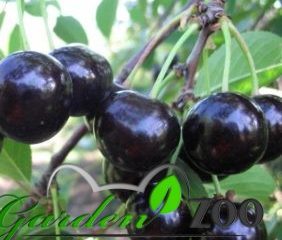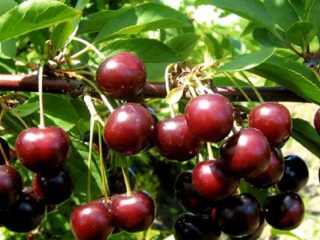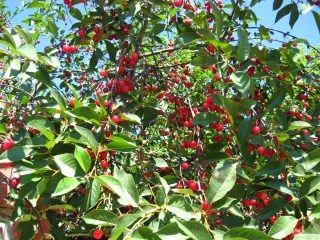Content
Cherry Zhivitsa is a unique hybrid of cherries and sweet cherries, obtained in Belarus. This variety has many names: Duke, Gamma, Cherevishnya and others. The early ripening Griot Ostheimsky and Denisena Zheltaya were chosen as the parents of this variety. It was included in the State Register in 2002, and since 2005 its active cultivation began in Russia and Ukraine.
Description of Zhivitsa cherry
The plant has an almost straight trunk and a rounded crown, slightly elongated from bottom to top. The density of the branches is average, the foliage is high. The branches are raised and sagging. The color of the trunk is brownish-gray.
The leaves have an elongated shape. Their sizes are about 12 cm in length and 3-4 in width. Color – rich green. Most of the buds are formed on the shoots of the current year.
The flowers are small and white. The flowering period begins in mid-May.The variety is self-sterile, that is, fruiting without pollinators will be practically absent.
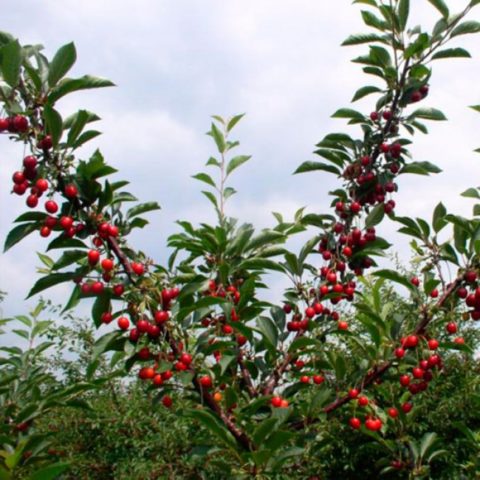
Top of the crown of the Zhivitsa cherry
The variety is classified as early ripening and winter-hardy. Recommended for cultivation throughout Belarus and Ukraine, as well as in central Russia. However, due to its good frost resistance, it adapts well to colder regions. There is numerous evidence of the successful cultivation of Zhivitsa cherries in the regions of the Urals and Western Siberia.
The hybrid has also adapted in the South. It is successfully grown in the North Caucasus and the Astrakhan region, although it has no commercial importance in these regions, since more productive heat-loving varieties can be grown in them.
Dimensions and height of Zhivitsa cherry
The diameter of the plant trunk rarely exceeds 10-12 cm. The rounded crown measures from 1.5 to 2.5 m. The height of the Zhivitsa cherry can range from 2.5 m to 3 m.
Description of fruits
Zhivitsa cherry berries are round in shape and medium in size. Their weight does not exceed 3.7-3.9 g. They have relatively fragile, delicate skin of a dark red color. The pulp of the hybrid is dense, but at the same time very juicy. It has the same color as the skin. The stone is small in size, freely separated from the pulp.
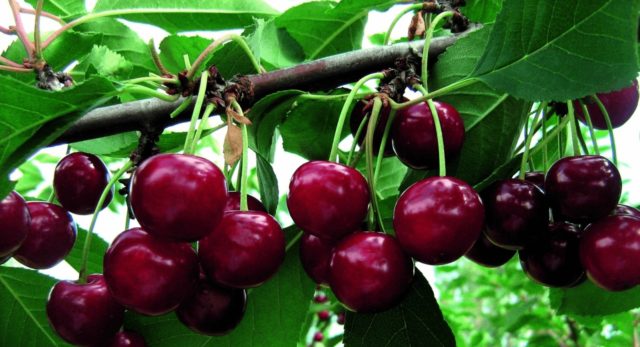
Ripe Zhivitsa cherry fruits
The taste is rated as very good, approaching excellent. There is a barely noticeable sourness in it. On a five-point scale, the taste of Zhivitsa cherry is rated at 4.8 points. The use of fruits is universal; they are consumed raw and processed. When preserved, they perform well, do not wander or explode.
Pollinators for Zhivitsa cherry
All cherry-cherry hybrids do not yet have self-fertile specimens.This is a serious problem for breeders, which they have been struggling with for decades. Cherry Zhivitsa was no exception. In addition, it does not have the possibility of cross-pollination with its own variety or related ones. For this purpose, all Dukes need only parent cultures.
The previously mentioned Griot and Denisenu can be used as a pollinator, but the use of closely related varieties is also acceptable. These include: Seedling No. 1, Novodvorskaya, Vyanok.
As a last resort, you can try to pollinate with an unrelated crop. Any variety that blooms around this time (1-2 decades of May) is suitable for this task. It is possible that it will be possible to find a previously unknown effective pollinator for the Zhivitsa cherry.
According to gardeners, the minimum required number of pollinating varieties for Zhivitsa cherry should be 3-4.
Main characteristics
The hybrid has high performance characteristics. This is one of the most profitable varieties for growing in cold climates, although some gardeners note the average yield of the variety. On the other hand, this indicator is quite acceptable for a frost-resistant crop with fruits of similar quality.
Drought resistance, frost resistance
The variety is highly drought-resistant. Moreover, frequent watering is not recommended. Moisture should be added to the Zhivitsa cherry only when there is a critical lack of moisture. The root system of trees is very powerful and can penetrate to a depth of several meters.
The frost resistance of the variety is high. The tree is able to withstand winters with temperatures dropping to -25 °C. In the conditions of the Middle Zone, in Belarus and Ukraine, no freezing was observed even in the most severe winters.
Productivity
The Zhivitsa cherry hybrid ripens in mid-summer. Fruiting dates begin at the end of June or in the first ten days of July. The variety is fast-bearing - already in 3-4 years of life you can reap abundant harvests.
The yield, even with minimal care, is about 100 kg per hundred square meters. With proper application of fertilizing and compliance with planting agricultural techniques, record figures are about 140 kg from the same area. On average, one tree produces about 12-15 kg of fruit.
The scope is universal. They are used for making juice and compote, as a filling for baked goods. When preserved, despite the relatively soft skin, the fruits retain their integrity. The transportability and keeping quality of the variety are satisfactory.
Advantages and disadvantages
The positive qualities of the Zhivitsa cherry hybrid include:
- high productivity;
- excellent taste of the fruit;
- versatility in application;
- precociousness;
- winter hardiness;
- resistance to most diseases;
- good bone separation.
Disadvantages of the variety:
- the need for several varieties of pollinators.
Landing rules
Planting Zhivitsa cherry does not have any special features. Recommendations may only relate to the timing of planting and the placement of trees on the site. The remaining points (depth of the hole, applied fertilizers, etc.) are standard for cherries in a temperate climate.
Recommended timing
It is recommended to plant Zhivitsa cherry in the spring.Autumn planting is not prohibited, but in this case the seedling must be completely protected from frost using heat-insulating material.
Site selection and soil preparation
There are no special requirements for site selection and soil quality. Cherry Zhivitsa grows well in any type of soil. The only important recommendation is that the site should be sunny.

Cherry seedlings Zhivitsa
To obtain good yields, a planting pattern of 3 m by 5 m is recommended. In this case, the trees can be placed either in even rows or in a checkerboard pattern.
How to plant correctly
The planting algorithm is standard: seedlings 1-2 years old are placed in holes with a diameter of 60 cm and a depth of 50-80 cm. Up to 2 buckets of humus are placed at the bottom of the hole, which is placed in a slide.
A peg is driven into the center of the hole, to which the seedling is tied. Its root system is evenly distributed along the slopes of the hill, sprinkled with soil, compacted and watered with 20 liters of water.
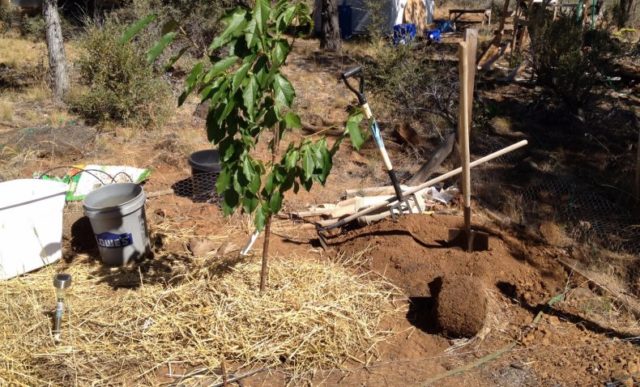
It is recommended to mulch the trunk circle with a layer of sawdust or freshly cut grass for the first two years after planting.
Features of care
Caring for Zhivitsa cherries is standard. This includes infrequent watering, fertilizing in poor soils and regular pruning at the end of the season.
Watering and fertilizing schedule
Watering is done more often than once every 2-3 weeks, since the root system of adult trees is branched. If there is a sufficient level of precipitation, artificial irrigation may not be necessary at all.
Feeding is done twice per season:
- in early spring - nitrogen components (no more than 20 g per tree);
- at the end of autumn - superphosphate and potassium fertilizers (30 and 20 g per plant, respectively).
Trimming
It forms a crown on its own, so it does not need any specific pruning. However, it is believed that the further north the growing area, the shorter the height of the tree as a whole. In very cold regions (with winters when the temperature drops to -30 °C), it is recommended to form a trunk and crown in a bush-like form.
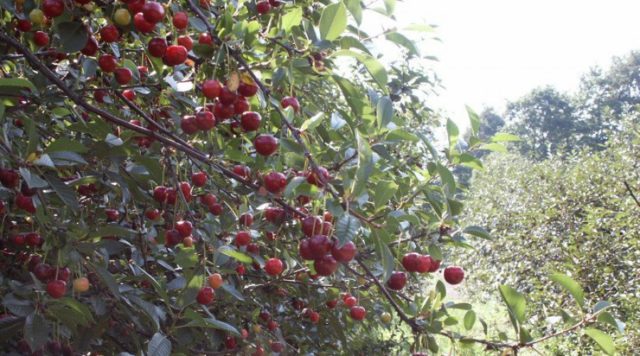
The crown is too thick, requiring regulatory pruning
Other types of pruning (sanitary, thinning and stimulating) have no special features; they are performed as needed.
Preparing for winter
The Zhivitsa cherry variety does not require any special procedures in preparation for wintering. It is recommended to carry out sanitary pruning at the end of October and whiten the trunks to protect them from rodents.
Diseases and pests
Cherry Zhivitsa has good disease resistance. However, it is recommended to carry out regular measures to counteract diseases such as coccomycosis and moniliosis.
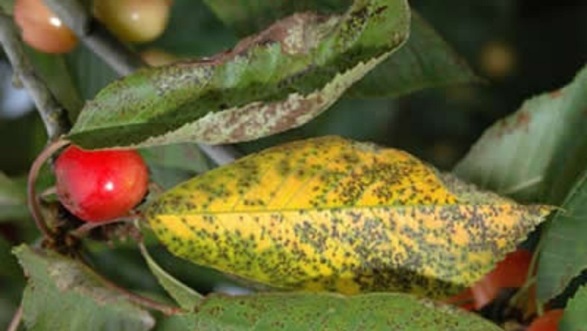
Cherry coccomycosis
These measures include regularly digging up the soil at the beginning and end of the season, as well as destroying dry grass and leaves in late autumn. It is recommended to spray trees and soil in the tree trunk with copper-containing preparations;
- copper chloroxide 0.4%;
- Bordeaux mixture 3%;
- copper sulfate 4.5%.
These measures should be applied during kidney swelling.
Conclusion
Cherry Zhivitsa is an early ripening hybrid of cherries and sweet cherries, intended for cultivation in central Russia, as well as in some relatively cold regions. Due to the unpretentiousness of the plant, the good taste of the fruits and the versatility of their use, this variety is one of the most successful for private cultivation in most regions.Plant productivity indicators are quite high.


